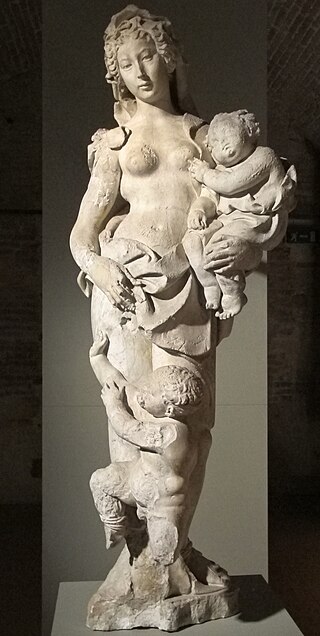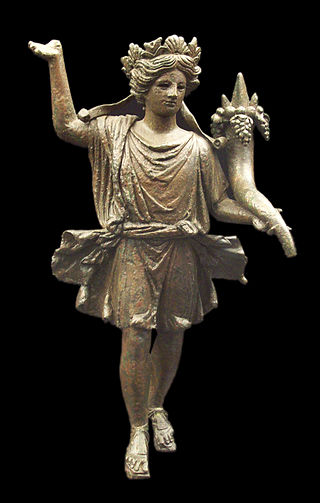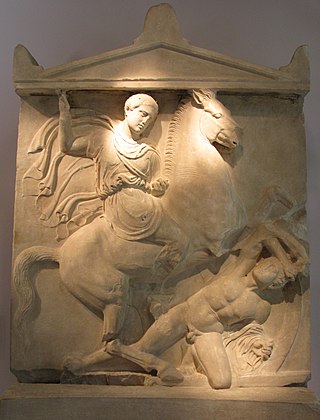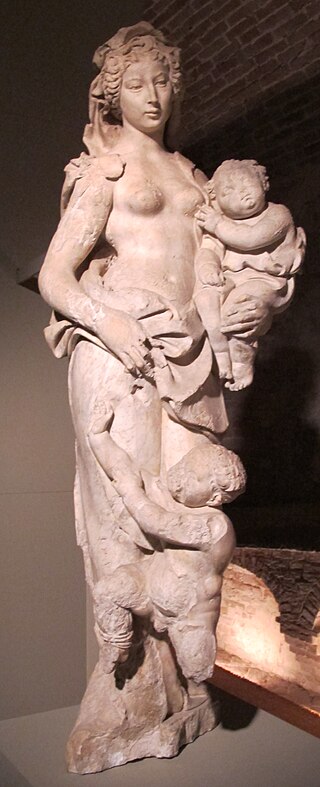Related Research Articles

Acca Larentia or Acca Larentina was a mythical woman, later a goddess of fertility, in Roman mythology whose festival, the Larentalia, was celebrated on December 23.

In Roman mythology, Faustulus was the shepherd who found the infant Romulus and his twin brother Remus along the banks of the Tiber River as they were being suckled by the she-wolf, Lupa. According to legend, Faustulus carried the babies back to his sheepfold for his wife Acca Larentia to nurse them. Faustulus and Acca Larentia then raised the boys as their own. Romulus later killed King Amulius of Alba Longa and his brother Remus before founding the city of Rome "in the place where they [Romulus and Remus] had been raised."
In Roman mythology, Dea Tacita also known as Dea Muta or Muta Tacita was a goddess of the dead. Ovid's Fasti includes a passage describing a rite propitiating Dea Tacita in order to "seal up hostile mouths / and unfriendly tongue" at Feralia on 21 February. Dea Tacita is the same as the naiad Larunda. According to Ovid this occurred because Dea Tacita had her tongue ripped off by Jupiter. Jupiter was angry with her because she told the nymph Juturna to flee from him because he planned to rape her. In this guise, Dea Tacita was worshipped at a festival called Larentalia on 23 December. Goddesses Mutae Tacitae were invoked to destroy a hated person: in an inscription from Cambodunum in Raetia, someone asks "ut mutus sit Quartus" and "erret fugiens ut mus". Plutarch, who describes Tacita as a Muse, states that Numa Pompilius credited Tacita for his oracular insight and taught the Romans to worship her.

In Roman mythology and religion, Quirinus is an early god of the Roman state. In Augustan Rome, Quirinus was also an epithet of Janus, as Janus Quirinus.

Festivals in ancient Rome were a very important part in Roman religious life during both the Republican and Imperial eras, and one of the primary features of the Roman calendar. Feriae were either public (publicae) or private (privatae). State holidays were celebrated by the Roman people and received public funding. Games (ludi), such as the Ludi Apollinares, were not technically feriae, but the days on which they were celebrated were dies festi, holidays in the modern sense of days off work. Although feriae were paid for by the state, ludi were often funded by wealthy individuals. Feriae privatae were holidays celebrated in honor of private individuals or by families. This article deals only with public holidays, including rites celebrated by the state priests of Rome at temples, as well as celebrations by neighborhoods, families, and friends held simultaneously throughout Rome.

In ancient Roman religion, the Arval Brethren or Arval Brothers were a body of priests who offered annual sacrifices to the Lares and gods to guarantee good harvests. Inscriptions provide evidence of their oaths, rituals and sacrifices.

In ancient Roman religion and mythology, Tellus Mater or Terra Mater is the personification of the Earth. Although Tellus and Terra are hardly distinguishable during the Imperial era, Tellus was the name of the original earth goddess in the religious practices of the Republic or earlier. The scholar Varro (1st century BC) lists Tellus as one of the di selecti, the twenty principal gods of Rome, and one of the twelve agricultural deities. She is regularly associated with Ceres in rituals pertaining to the earth and agricultural fertility.
Larunda was a naiad nymph, daughter of the river Almo and mother of the Lares Compitalici, guardians of the crossroads and the city of Rome. In Ovid's Fasti she is named Lara.

Magha is the eleventh month of the Hindu calendar, corresponding to January/February of the Gregorian calendar. In India's national civil calendar, Magha is also the eleventh month of the year, beginning on 20 January and ending on 18 February.

In ancient Roman religion, the Flamen Martialis was the high priest of the official state cult of Mars, the god of war. He was one of the flamines maiores, the three high priests who were the most important of the fifteen flamens. The Flamen Martialis would have led public rites on the days sacred to Mars. Among his duties was the ritual brandishing of the sacred spears of Mars when the Roman army was preparing for war.

Lares were guardian deities in ancient Roman religion. Their origin is uncertain; they may have been hero-ancestors, guardians of the hearth, fields, boundaries, or fruitfulness, or an amalgam of these.

Roman gardens and ornamental horticulture became highly developed under Roman civilization, and thrived from 150 BC to 350 AD. The Gardens of Lucullus, on the Pincian Hill in Rome, introduced the Persian garden to Europe around 60 BC. It was seen as a place of peace and tranquillity, a refuge from urban life, and a place filled with religious and symbolic meaning. As Roman culture developed and became increasingly influenced by foreign civilizations, the use of gardens expanded.
Boscotrecase is a comune (municipality) in the Metropolitan City of Naples in the Italian region Campania, located about 20 km southeast of Naples.

Heroic nudity or ideal nudity is a concept in classical scholarship to describe the un-realist use of nudity in classical sculpture to show figures who may be heroes, deities, or semi-divine beings. This convention began in Archaic and Classical Greece and continued in Hellenistic and Roman sculpture. The existence or place of the convention is the subject of scholarly argument.

The Berthouville treasure is a hoard of Roman silver uncovered by ploughing in March 1830 at the hamlet of Villeret in the commune of Berthouville in the Eure département of Normandy, northern France. Purchased at the time of discovery for a modest 15,000 francs, the treasure is conserved in the Cabinet des Médailles at the Bibliothèque nationale, Paris.

In ancient Roman religion and myth, the Querquetulanae or Querquetulanae virae were nymphs of the oak grove (querquetum) at a stage of producing green growth. Their sacred grove (lucus) was within the Porta Querquetulana, a gate in the Servian Wall. According to Festus, it was believed that in Rome there was once an oakwood within the Porta Querquetulana onto the greening of which presided the virae Querquetulanae.
The “Murlo Cowboy” is a famous akroteria that is part of over a dozen Etruscan sculptures, discovered in the ruins of the Archaic Building at the excavation site at Murlo in the Provice of Siena, Tuscany, Italy during the sixth century BCE. On Etruscan buildings, statues of gods, heroes, and ancestors were often placed on the ridges of roofs to protect votive offerings. This protective concept dates back to Etruscan beliefs from the preceding Orientalizing Period.
Olga Palagia is Professor of Classical Archaeology at the National and Kapodistrian University of Athens and is a leading expert on ancient Greek sculpture. She is known in particular for her work on sculpture in ancient Athens and has edited a number of key handbooks on Greek sculpture.

Remoria is a place associated with the legendary founding of Rome by Romulus and Remus where, according to Roman tradition, Remus saw six birds land and which he chose as an auspicious location for the future city. It is also where he was buried, after being killed by his brother Romulus during a dispute.

Caroline Morris Galt was an American college professor. She taught Greek, Latin, art history and archaeology courses at Mount Holyoke College, and was the first woman appointed as an annual professor at the American School of Classical Studies at Athens.
References
- ↑ Taylor, Lily Ross (1925-07-01). "The Mother of the Lares". American Journal of Archaeology. 29 (3): 299–313. doi:10.2307/497560. ISSN 0002-9114. JSTOR 497560. S2CID 192992171.
- ↑ Laing, Gordon (1921). "The Origin of the Cult of the Lares". Classical Philology. 16 (2): 124–140. doi:10.1086/360343. ISSN 0009-837X. JSTOR 262829. S2CID 161491522.
- ↑ Abraham Rees (1819). The Cyclopædia: Or, Universal Dictionary of Arts, Sciences, and Literature. Longman, Hurst, Rees, Orme & Brown. pp. 313–.
- ↑ Wouter W. Belier (1991). Decayed Gods: Origin and Development of Georges Dumézil's "Idéologie Tripartie". BRILL. pp. 91–. ISBN 90-04-09487-3.
- ↑ Krappe, Alexander H. (1942-10-01). "Acca Larentia". American Journal of Archaeology. 46 (4): 490–499. doi:10.2307/499082. ISSN 0002-9114. JSTOR 499082. S2CID 245275195 – via University of Chicago Press.
- ↑ Phillips, C. Robert (2015-12-22). "Acca Larentia". Oxford Research Encyclopedia of Classics. doi:10.1093/acrefore/9780199381135.013.12. ISBN 978-0-19-938113-5 . Retrieved 2022-12-29.
- ↑ Mirković, Miroslava (2015). "Acca Larentia: Myth and Model". Belgrade Historical Review. 6– via ResearchGate.
- ↑ Limoges, Sarah. "Reconstructing religion: Augustus and the «Fratres Arvales»". escholarship.mcgill.ca. Michael Fronda (Internal/Supervisor). Retrieved 2022-12-29.
- ↑ Robert E. A. Palmer (2 October 1970). The Archaic Community of the Romans . Cambridge University Press. pp. 113–. ISBN 978-0-521-07702-6.
- ↑ Palmer, Robert E. A.; Palmer, Robert E. A. (1970-10-02). The Archaic Community of the Romans. Cambridge University Press. ISBN 978-0-521-07702-6.
- ↑ Henderson, Helene, and Thompson, Sue Ellen, ed. “Larentalia.” Holidays, Festivals and Celebrations of the World Dictionary. Vol. 2. Detroit: Omnigraphics, 1997.
- ↑ Wiseman, T. P. (2004). "Where was the nova via?". Papers of the British School at Rome. 72: 167–183. doi:10.1017/S0068246200002701. ISSN 2045-239X. S2CID 162364465 – via Cambridge Core.
- ↑ Henderson, Helene, ed. "Larentalia." Holidays, Symbols and Customs. Vol. 4. Detroit: Omnigraphics, 2009
- ↑ Holleman, A. W. J. (1976). "End and Beginning in the Ancient Roman Year (A Sabine element ?)". Revue belge de Philologie et d'Histoire. 54 (1): 63. doi:10.3406/rbph.1976.3076.